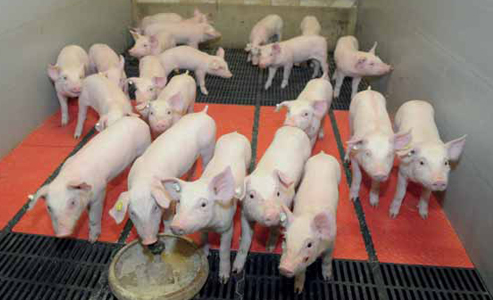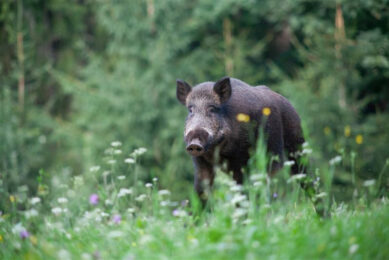Blood plasma – more than flavour or globulins?

Ever since antibiotics for preventive use have been disallowed in the European Union, companies and institutes have been searching for alternative ingredients that could help fill that gap. Blood plasma, by influencing pig health in probably more ways than hitherto thought, can contribute to achieving good results.
Antibiotic growth promoters have had a strong positive effect on individual pig growth, when dosed in pig feed. Their mode of action in growth promotion (prophylaxis) has been described extensively.
The practice is as simple as it is effective. Feeding low, sub-therapeutic amounts of antibiotics to pigs has two effects in the gastro-intestinal tract. They can suppress several sensitive bacteria populations, whose microbial fermentation consumes part of the net energy – as well as suppressing pathogenic bacteria.
Due to the risk of bacteria resistance, growth promoting antibiotics have been forbidden in the European Union since 2006 – outside the EU the practise continues. Since then there has been a dearth in nutritional supplements in the EU that protect and assist piglets in getting through those first difficult weeks of life. This ‘gap’ has been filled by a large variety of non-antibiotic feed ingredients, all having their own modes of action, functions, disadvantages, efficacy and qualities.
Blood plasma
Like antibiotics, blood plasma is known to have a strong growth promoting as well as a beneficial effect on health. With relatively small amounts of animal plasma in piglet feed, growth figures are boosted. Effects of improved growth, reduced diarrhoea and reduced mortality have been documented consistently over the years and in various animal species.
Traditionally, the success of the addition of animal plasma has been attributed to two key characteristics – its good flavour and the presence of large amounts of globulins. Do these characteristics tell, however, the whole story behind animal plasma? The answer is, perhaps not.
APC, headquartered in Ankeny, Iowa, USA, producer of several animal plasma products for the livestock market, continues to perform research in order to unveil more details of the mode of action of animal plasma.In a recent webinar for the European feed market, organised by APC Europe, Dr Joe Crenshaw, the company’s director of technical services, speculated beyond both known modes of action. About palatability he said, “Typically pigs fed diets with plasma consume more feed compared to pigs fed diets without plasma. There has been a study showing that nutrient utilisation is improved for pigs fed diets with plasma, even if the feed intake of the pigs fed diets with plasma are intentionally restricted to the same feed intake level as pigs fed control diets.” He added that his company published information showing that the globulin protein fraction of plasma shows a lot of the growth response, however, it still doesn’t explain all of the responses animals have to functional proteins.
So if there are additional modes of action – what are they?
Immune system
A short recap: Blood plasma is about 92% water and 6-9% proteins. These proteins can further be subdivided into albumins (60%), globulins (36%) and fibrinogens (4%) – together these are known as ‘serum proteins’. The largest of globulins are known as gamma-globulins, and since some of them have a function as an antibody, they are also known as immunoglobulins. As such, they bind pathogens or antigens in the lumen of the gut to prevent them from damaging the intestinal barrier.
Crenshaw stated that a relatively novel view is that plasma proteins support and maintain a normal immune system response in animals undergoing various stressors. He illustrated this by explaining the normal function of a pig’s immune system, as shown in Figure 1. “Weaning in itself is a stress.
When a pig is weaned, typically pigs are transitioned from sow milk to wet or dry feed, they are comingled with pigs from other litters and on top of that they are exposed to pathogens from other pigs and the nursery environment.”Responding to the stress signals, a pig’s body will prioritise this ‘problem’ and therefore growth is temporarily relegated to a lower priority. Cytokines, or signalling molecules, play an important role in this response, as these are released by immune cells as soon as a stress situation occurs. Multiple effects on body organs and cells follow. Crenshaw said, “Once the immune system is activated, pro-inflammatory mediators signal the brain to reduce feed intake, while at the same time the liver produces acute phase proteins designed to defend the body against invading pathogens or antigens. Also, fat, muscle and even bone tissue is broken down to help provide nutrient support for the immune system to respond and return to normal.”
Mode of action
Crenshaw commented on a research paper by Miquel Moretó, University of Barcelona, and Anna Pérez-Bosque, APC Europe, published in 2009, with the same message. The researchers aimed to unravel what exactly constitutes the mode of action of animal plasma at the mucosal level in case of an intestinal inflammation – and used rats to establish this. Observing the antibody effect, they said: “Biologically active compounds present in plasma supplements can also interact directly with mucosal immune cells. The plasma-induced changes in mucosal cytokine profile will prevent or reverse deleterious effects resulting from immune system activation.”
The researchers noted that spray-dried plasma reduced the production of mucosal pro-inflammatory cytokines – and increased the production of anti-inflammatory cytokines. Similar results were noted in lung mucosal fluid for mice fed plasma diets and subjected to a model of acute lung inflammation.
Weanling pigs
The big question for pig producers is, whether this mode of action – and its effects – could be observed in weanling piglets. Crenshaw showed a very recent paper in The Journal of Nutrition, by Ralph Michael Peace and Adam Moeser, North Carolina State University and a group of researchers from APC, that zoomed in on this question.
A total of 48 Yorkshire cross weanling piglets of a similar weight all received one of three experimental nursery diets containing 0, 2.5, or 5% spray-dried porcine plasma. At seven or 14 days post-weaning, they were culled to perform studies on their ileum and colon – and their faeces were also scored.
The researchers concluded that dietary inclusion of spray-dried porcine plasma into post-weaning pig diets ameliorated intestinal barrier dysfunction, inflammation and diarrhoea. The effects on barrier function and inflammation appeared to be dependent on the location in the intestine (ileum or colon) and whether it was measured at day 7 or 14. Exact mode of action therefore needs to be investigated further, they concluded.
As for the faecal scores, the researchers observed a reduction with 5% spray-dried porcine plasma feeding at seven and 14 days post-weaning, attributing this to ‘anti-secretory properties in the colon’.
Results of plasma
Although plasma cannot be used as medical treatment for individual pigs, one of APC’s central messages to the European feed market at the webinar was that plasma can perform in a manner similar to antimicrobial treatments.
The other speaker at the webinar, Dr Javier Polo, the company’s vice president on R&D, presented data showing that antimicrobials and plasma were equally effective in reducing the effects of oral challenge of pigs with E. coli, and even have been shown to yield better results in various trials to
improve average daily feed intake, see Figure 2. He said that these publications suggested that plasma proteins may interact with E. coli in the intestine to reduce exposure and subsequent immune activation. He referred to Dr Crenshaw, echoing that another possible mode of action would be that plasma reduces the intestinal damage and inflammation associated with E. coli challenge. PP











